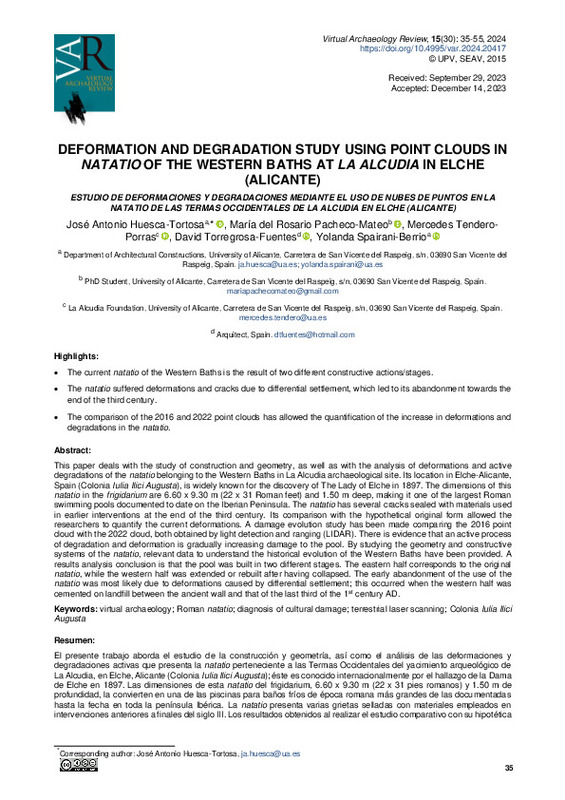|
Resumen:
|
[EN] This paper deals with the study of construction and geometry, as well as with the analysis of deformations and active degradations of the natatio belonging to the Western Baths in La Alcudia archaeological site. Its ...[+]
[EN] This paper deals with the study of construction and geometry, as well as with the analysis of deformations and active degradations of the natatio belonging to the Western Baths in La Alcudia archaeological site. Its location in Elche-Alicante, Spain (Colonia Iulia Ilici Augusta), is widely known for the discovery of The Lady of Elche in 1897. The dimensions of this natatio in the frigidarium are 6.60 x 9.30 m (22 x 31 Roman feet) and 1.50 m deep, making it one of the largest Roman swimming pools documented to date on the Iberian Peninsula. The natatio has several cracks sealed with materials used in earlier interventions at the end of the third century. Its comparison with the hypothetical original form allowed the researchers to quantify the current deformations. A damage evolution study has been made comparing the 2016 point cloud with the 2022 cloud, both obtained by light detection and ranging (LIDAR). There is evidence that an active process of degradation and deformation is gradually increasing damage to the pool. By studying the geometry and constructive systems of the natatio, relevant data to understand the historical evolution of the Western Baths have been provided. A results analysis conclusion is that the pool was built in two different stages. The eastern half corresponds to the original natatio, while the western half was extended or rebuilt after having collapsed. The early abandonment of the use of the natatio was most likely due to deformations caused by differential settlement; this occurred when the western half was cemented on landfill between the ancient wall and that of the last third of the 1st century AD.
[-]
[ES] El presente trabajo aborda el estudio de la construcción y geometría, así como el análisis de las deformaciones y degradaciones activas que presenta la natatio perteneciente a las Termas Occidentales del yacimiento ...[+]
[ES] El presente trabajo aborda el estudio de la construcción y geometría, así como el análisis de las deformaciones y degradaciones activas que presenta la natatio perteneciente a las Termas Occidentales del yacimiento arqueológico de La Alcudia, en Elche, Alicante (Colonia Iulia Ilici Augusta); éste es conocido internacionalmente por el hallazgo de la Dama de Elche en 1897. Las dimensiones de esta natatio del frigidarium, 6.60 x 9.30 m (22 x 31 pies romanos) y 1.50 m de profundidad, la convierten en una de las piscinas para baños fríos de época romana más grandes de las documentadas hasta la fecha en toda la península Ibérica. La natatio presenta varias grietas selladas con materiales empleados en intervenciones anteriores a finales del siglo III. Los resultados obtenidos al realizar el estudio comparativo con su hipotética forma original han permitido cuantificar sus deformaciones actuales. Se ha realizado un estudio de evolución de daños comparando la nube de puntos obtenida en el año 2016 con la nube realizada en el año 2022, ambas obtenidas mediante LIDAR (light detection and ranging). Se ha evidenciado que existen degradaciones y deformaciones activas que paulatinamente van aumentando los daños en la natatio. El estudio de la geometría y de los sistemas constructivos de la natatio también han aportado datos relevantes para la comprensión de la evolución histórica del conjunto de las Termas Occidentales. Del análisis de los resultados de este estudio se concluye que la actual natatio se construyó en dos fases diferentes. La mitad oriental coincide con la natatio original y la mitad occidental se amplió o se reconstruyó tras arruinarse. El temprano abandono del uso de la natatio se debió, con toda probabilidad, a las deformaciones provocadas por asientos diferenciales al cimentar la mitad occidental sobre terrenos de relleno entre la muralla antigua y la del último tercio del siglo I.
[-]
|









